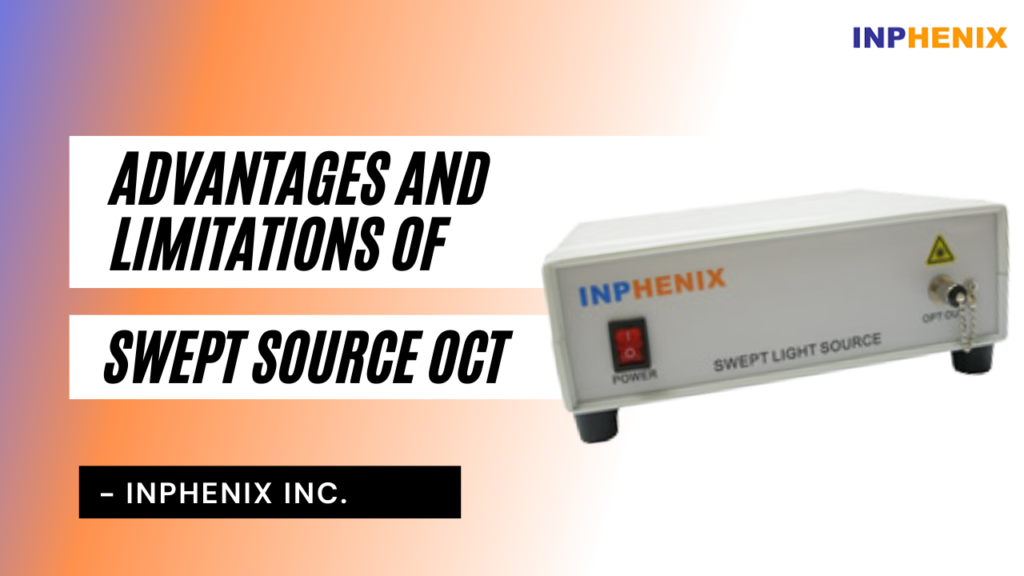
Medical technology has advanced substantially over the past few years. It has not only evolved but has also become more affordable over time. Swept Source OCT, which stands for Swept Source Optical Coherence Tomography, is one such medical technology.
Swept source OCT, which was introduced in 2012, has grown in popularity due to its deeper penetration strength. Ultimately, it has had a favorable impact on and made a significant contribution to the studies of the vitreous body.
In this blog, we will look at the benefits and drawbacks of swept source optical coherence tomography to better understand why this diagnostic technique has grown so popular in such a short period of time. But first, let’s look at how swept source OCT (SS-OCT) differs from spectral-domain OCT (SD-OCT).

A. To detect choroidal neovascularization (CNV), both SD-OCT and SS-OCT are used. Moreover, both SD-OCT and SS-OCT employ Fourier domain detection techniques. However, spectral domain OCT equipment uses broadband near-infrared SLDs as a light source, whereas SS-OCT uses tunable swept lasers.
B. The central wavelength of SD-OCT is roughly 1050nm, whereas the central wavelength of SS-OCT is 1060nm.
C. The SD-OCT A-scan rate is 120 kHz, while the SS-OCT A-scan rate is 100 kHz.
D. The SD-OCT imaging depth range is 12 mm, whereas the SS-OCT imaging depth range is 10 mm.
E. SS-OCT is easy to use and requires minimal technical knowledge. SD-OCT, on the other hand, is difficult to operate and requires technical competence to operate.
These are the five primary distinctions between SD-OCT and SS-OCT. Let us now look at the advantages of SS-OCT.
The advantages of swept source OCT have contributed to its popularity and widespread acceptance. The following are some of the significant advantages of SS-OCT over SD-OCT.
1. One advantage of swept source optical coherence tomography imaging over spectral domain OCT is the quicker scanning speed, which allows for better scan patterns and bigger scan areas for a given acquisition time compared to SD-OCT images.
2. Another advantage of SS-OCT is that it employs an unobtrusive light source. Compared to the visible light source of the SD-OCT, the invisible light source is less distracting for patients. This will allow for a clearer picture of the eye and a more thorough analysis of the condition.
3. Moreover, the long wavelength allows for clear pictures of deep ocular tissues such as the choroid and lamina cribrosa. Additionally, because there is less light scattering by lens opacities, SS-OCT can offer sharper images in individuals with cataracts than traditional OCT.
These are the three key advantages of SS-OCT over SD-OCT. Let’s have a look at some of the primary limitations of SS-OCT.
1. The first significant disadvantage of SS-OCT is that it is more costly than SD-OCT since it demands a narrow linewidth, high speed, and frequency.
2. In addition, when compared to SD-OCT, SS-OCT has a lower axial resolution, a poor signal-to-noise ratio, less motion distortion, and no normative databases – all of which are significant for glaucoma imaging.
3. Furthermore, due to the considerable scattering generated by the difference in refractive index between serum and the cytoplasm of red blood cells, swept source OCT cannot normally penetrate blood.
These are the three most significant limitations of swept source lasers. Inphenix offers light sources and amplifiers designed and optimized for the biomedical industry. We hope that this information has provided you with a better understanding of why SS-OCT is so popular in the medical industry.
If you want to know more about swept-source optical coherence tomography, you can check our blog: Swept Source OCT – History, Evolution, and Advantages.
Inphenix is a light source manufacturer based in the United States that works with a variety of optical devices such as swept source lasers, distributed feedback lasers, gain chips, Fabry Perot lasers, and VCSELs. Each of our products is highly advanced, affordable, and interoperable with a wide range of devices.
